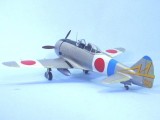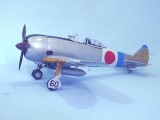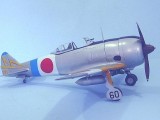Nakajima’s Demon-Killer – Hasegawa 1/32 Ki/44 “Shoki” (Tojo)
This Hasegawa Ki.44-1b "Shoki" is built essentially out of the box, other than the use of Eduard JAAF seatbelts. It depicts a Ki.44 flown on home defense by the 47th Sentai, the most effective unit flying the Ki.44 in opposing the B-29s. The model was painted overall with Alclad Duraluminum, with the fabric control surfaces in Tamiya JAAF Grey. All other markings are decals, other than the leading edge stripes, which had to be painted with the decals failed. I would recommend painting and masking the home defense "bandages."
The Nakajima Ki.44 Shoki” (“Demon-killer”), known to the Allies as “Tojo,” represented a major change in design and operational philosophy by the Japanese Army Air Force. Previously, all fighter designs had emphasized maneuverability on the horizontal plane, even at the cost of speed and heavier armament. The Ki.44 was the first “western” aircraft designed in Japan, i.e., a fighter that emphasized speed and performance in the vertical plane and can be considered something of a “halfway house” between the Ki.43 Hayabusa and the Ki.84 Hayate, which was the full realization of this change in philosophy.
First flown in August 1940, the prototypes went through several detail design changes to maximize speed. Once these seven prototypes were brought up to “pre-production” standard, they were issued to the 47th Dokoritsu Hiko Chutai on September 15, 1941. Two more hand-built prototypes had reached the “Kingfisher” Chutai by the end of the month, and the Chutai moved to Canton, China at the end of November. When the Pacific War broke out a week later, the unit was assigned to the 12th Sentai, which was equipped with Ki.27s. And committed to the invasion of Malaya. At first, the aircraft presented numerous mechanical problems.
The Ki.44 entered combat for the first time on January 1, 1942, when a flight of three Ki.44s led by Captain Yasuhiko Kuroe attacked three Buffalos of 21 and 453 Squadrons in the vicinity of Johore Baru, just north of Singapore, with Captain Kuroe scoring that first kill.
The Ki.44 was not really designed for fighter-versus-fighter combat, being intended as a fast-climbing high altitude interceptor. The design requirements were the crystallization of experience gained in the Khalkin Gol incident in September 1939, when the Ki.27s had been incapable of intercepting the fast Soviet SB-2 bombers. By coincidence, Nakajima had tried to interest the Koku Hombu in just such a fighter back in 1935, but it had been deemed too experimental, not to mention it violated everything the conservative Japanese Army fighter pilots looked for in a fighter. The specification that emerged in late 1939 called for a fighter with a top speed of 373 m.p.h., the ability to attain 5,000 meters' altitude at normal operating weights in less than five minutes, and an armament of two 7.7mm and two 12.7 mm machine guns. At the time, this was the most advanced requirement ever issued by the Koku Hombu.
Nakajima elected to use the Ha-42 14-cylinder radial, providing 1,185 h.p., and designed the smallest possible airframe that could carry this engine. With a wing loading of 30 pounds per square foot, the airplane performed like nothing else seen by Japanese Army pilots, even with the addition of the “butterfly” area-increasing flap system.
Pilots initially thought that the Ki.44 was a “demon-killer,” but one that was out to kill its pilots. Since the pilots were unused to its unforgiving performance, the JAAF decided that only highly-experienced pilots with more than 1,000 hours' flight time would be assigned to a unit operating the Shoki. Interestingly, as pilot standards decreased through the war, it was discovered that new, low-time pilots who did not have the experience of the earlier, lighter fighters, and the flying habits born from that experience, had no problem adjusting to the Ki.44 or to its follow-on, the even-heavier Ki.84.
Following the Doolittle Raid in April 1942, where the B-25s outran the Ki.27s they encountered, the 47th Chutai was brought back to Japan and turned into a Sentai with three Chutais, all equipped with the Ki.44, based at Narimasu Airfield for the defense of Tokyo.
In late 1942, the design was upgraded by changing engines to the Ha-109, which had a two-stage supercharger and produced 1,520 h.p. This was necessary since the 7.7mm fuselage weapons had been replaced at an early stage of production by the 12.7mm Ho-3 weapon originally carried in the wings, while the fuel tanks were given a rudimentary form of self-sealing and the pilot was provided back and head armor. The aircraft was designated Ki.44-II, with the primary production version being the Ki.44-II Otsu, (or Ki.44-IIb), with the four Ho-3 weapons. A limited number of Ki.44-II-Hei aircraft, equipped with 20mm Ho-5 cannons in the wings, were produced alongside the more numerous Otsu, and these aircraft began to appear operationally during 1943.
The 85th and 87th Sentais re-equipped with the Ki.44 in 1943 for the defense of the oil fields at Palembang in Borneo, and proved themselves quite capable interceptors when launched against B-24s of the Fifth Air Force that were flying unescorted missions. Even when the American bombers were escorted, the Ki.44s had the climb and dive performance to make one attack on the bombers, then out-diving the escorts - the way they had seen the AVG do it over Rangoon in early 1942. Ki.44s were also sent to Manchuria and Korea in 1944 to intercept B-29 raids coming from China. When the B-29s began raiding Japan from the Marianas in November 1944, the Shokis of the 47th Sentai, along with the Ki.61s of the 244th Sentai, proved themselves the most effective B-29 interceptors. Following two successful ramming attacks by 47th Sentai pilots in December 1944, the unit operated an independent Chutai with the specific mission of ramming Superfortresses. A total of twelve Sentais of the Japanese Army Air Force - the 9th, 22nd, 23rd, 29th, 47th, 59th, 64th, 70th, 85th, 87th, 104th and 246th - were equipped with the Ki.44 during the war. Additionally, the Manchoukouan Air force also received some Ki.44s, though they never saw combat.
Production of the Ki.44 ended in November 1944, with 1,224 aircraft delivered. Most unite re-equipped with the Ki.84, though the Ki.44 could still be seen in the skies over Japan to the end of the war.
The end of the war did not see the end of service for the Ki.44. The Nationalist Chinese 18th Squadron of the 12th Fighter Group equipped with Ki-44s formerly of the 9th Sentai, which had disbanded in Nanking, and of the 29th Sentai, which had surrendered on Formosa, and these Shokis were used during the Chinese Civil War. Additionally, The People's Liberation Army Air Force was given aircraft from the 22nd and 85th Sentais, who had surrendered to the Russians in Korea. The Ki.44s were flown by the Nationalist Air Force until the last two were finally retired in the early 1950s. As if that wasn't enough post-war service, the Indonesian People's Security Force captured a small number of the aircraft at numerous Japanese air bases throughout Indonesia, and used these in the during the Indonesian National Revolution of 1945––1949.















It looks gorgeous, Tom, I like it very much!
outstanding tom
Tom, you're "killing" me with these great Japanese fighters! The Japanese shelf in my display cabinet has only my lonely Monogram A6M5 and my "what if" Kyushu Shinden. Man, I've just got to get some more planes in there from Nippon. This is another beauty! Well-done indeed.
The Japanese shelf in my display cabinet has only my lonely Monogram A6M5 and my "what if" Kyushu Shinden. Man, I've just got to get some more planes in there from Nippon. This is another beauty! Well-done indeed.
Gary
Fortunately Hasegawa does 1/48 versions of all of these.
Beautiful, Tom. Unfortunately my Japanese stash consists only of Otaki 1/48, at this point. Yours certainly are encouraging.
Great model once again, and wonderful history lesson.
Do I remember correctly that the Japanese even mounted 40mm cannon on a few Shoki's?
They did, but it was a very low-velocity weapon and not effective.
Tom I am really enjoying your Japanese aircraft, they have been on my "to build" list for years, but I am trying to build some kits before I buy, BUT you are not helping me any! Wonderful build!
Beautiful finish work. Inspiring.
Interesting read Tom. If you squint your eyes it reminds one of a Thunderbolt. When I think WWII Japanese aircraft I always think "Zero", that aircraft seemed to grab all the legend status. Great job on the model, very authentic finish.
Mike's comment reminded me of the first time I saw a model of the Ki 44. I really didn't know my aircraft much, and this one was on display in a case, in American (captured) markings. I thought it was the sleekest looking Thunderbolt I'd ever seen. I've learned a little since then, but the first Ki 44 I built, was in those markings, in remembrance.